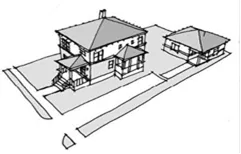Accessory Dwelling Units (ADU) and Junior Accessory Dwelling Units (JADUs)
An ADU is a secondary dwelling unit with complete independent living facilities for one or more persons and generally takes three forms:
- Detached: The unit is separated from the primary residential structure
- Attached: The unit is attached to the primary residential structure
- Repurposed Existing Space: Space (e.g., master bedroom or garage) within the primary residence is converted into an independent living unit
Government Code

Government Code Section 65583.1(a) allows a city or county to identify sites for ADUs based on the number of ADUs developed in the prior housing element planning period whether or not the units are permitted by right, the need for these units in the community, the resources or incentives available for their development, and any other relevant factors, as determined by the department. Nothing in this section reduces the responsibility of a city or county to identify, by income category, the total number of sites for residential development as required.
Local governments can employ a variety of development strategies and/or commit to specific program actions to address the adequate sites requirement, as provided in Government Code Section 65583(c)(1)). Under certain circumstances, a local government may credit their adequate sites requirement per income category through ADUs or JADUs based on the number of these units developed in the prior housing element planning period, whether or not the units are permitted by right, the need for these units in the community, the resources, or incentives available for their development, and any other relevant factors as determined by the Department. Nothing in this section reduces the responsibility of a city or county to identify, by income category, the total number of sites for residential development as required. As In addition to identifying vacant or underutilized land resources, local governments can address a portion of their adequate sites requirement through the provision of ADUs or JADUs.
To rely on ADUs or JADUs as part of an overall adequate sites strategy to accommodate (a portion) of the regional housing need, the element must include an estimate of the potential number of these units to be developed in the planning period based on an analysis that considers the following factors:
- the number of ADUs or JADUs developed in the prior planning period;
- community need for these types of housing units,
- the resources and/or incentives available that will encourage the development of ADUs; and
- the availability of ADUs and JADUs that will be part of the rental stock, rather than used as offices or guest houses,
- the unit must meet census definition of a housing unit, which can be found on the US Census Bureau website , and be reported to the Department of Finance (DOF) as part of the annual City and County Housing Unit Change Survey ; and
- other relevant factors as determined by HCD.
The projection of ADU and JADU development must be based on realistic capacity and development trends of ADUs and JADUs in the previous planning period. In addition, the housing element must describe and analyze factors that could affect ADU and JADU development within the planning period. At a minimum, the element should analyze development standards (i.e., heights, setbacks, minimum and maximum unit sizes, lot coverage, parking standards, etc.), zones allowing ADUs (by right), architectural review standards, fees and exactions, and any other potential constraints impacting the development of ADUs and JADUs.
ADU and JADU Affordability: The housing element should also include an analysis of the anticipated affordability of these units. The purpose of this analysis is to determine the housing need by income group that could be accommodated through ADU and JADU development. Affordability can be determined in a number of ways. As an example, a community could survey existing ADUs and JADUs for their rents and include other factors such as square footage, number of bedrooms, amenities, age of the structure and general location, including proximity to public transportation. Another method could examine market rates for reasonably comparable rental properties to determine an average price per square foot in the community. This price can be applied to anticipated sizes of these units to estimate the anticipated affordability of ADUs and JADUs.
City of Santa Cruz
Accessory Dwelling Unit (ADU) Development Program
The City of Santa Cruz's ADU Development program provides opportunities for additional affordable rental housing, while providing homeowners a chance to supplement mortgage payments. The program has received recognition nationwide and is the recipient of awards including League of California Cities 2004 Helen Putnam Award for Excellence and the Environmental Protection Agency 2004 National Award for Smart Growth Achievement Policies and Regulations. The program works implement the development of well-designed ADUs while helping to minimize the impact of population growth on the community by providing more rental housing in the developed core and promoting infill development and sustainable land-use patterns. Through the ADU Development Program, the City of Santa Cruz offers technical and financial assistance including an ADU manual detailing the development process, relevant zoning, design standards, building codes and showcases of ADU prototype designs.
What kind of environmental review is required for ADUs?
ADUs approved ministerially are statutorily exempt from CEQA pursuant to Section 15268 (Ministerial Projects) of the CEQA guidelines and Section 21080(b)(1) of the Public Resources Code. In addition, ADUs can be categorically exempt from CEQA pursuant to Sections15301 and 15303 of the CEQA guidelines, authority cited under Public Resources Code Section 21083 and 21087.
What is ministerial review?
Chapter 1062 requires development applications for ADUs to be considered ministerially without discretionary review or a hearing or, in the case where there is no local ordinance in compliance with subsections (a) or (c), a local government must accept the application and approve or disapprove the application ministerially without discretionary review In order for an application to be considered ministerially, the process must apply predictable, objective, fixed, quantifiable and clear standards. These standards must be administratively applied to the application and not subject to discretionary decision-making by a legislative body (for clarification see the definition of ministerial under California Environmental Quality Act (CEQA) Guidelines, (Section 15369).
An application should not be subject to excessively burdensome conditions of approval, should not be subject to a public hearing or public comment and should not be subject to any discretionary decision-making process. There should be no local legislative, quasi-legislative or discretionary consideration of the application, except provisions for authorizing an administrative appeal of a decision
How can a locality encourage ADUs?
Local governments can encourage ADU development through a variety of mechanisms.
- Develop information packets to market ADU construction. A packet could include materials for a ADUs application, explain the application process, and describe incentives to promote their development.
- Advertise ADUs development opportunities to homeowners on the community's web page, at community and senior centers, in community newsletters, and in local utility bills, etc.
- Establish and maintain an ADUs specialist in the current planning division to assist in processing and approving ADUs.
- Establish flexible zoning requirements, development standards, processing and fee incentives that facilitate the creation of ADUs (Government Code Section 65852.2(g)). Incentives include reduced parking requirements near transit nodes, tandem parking requirements, pre-approved building plans or design prototypes, prioritized processing, fee waivers, fee deferrals, reduced impact fees, reduced water and sewer connection fees, setback reductions and streamlined architectural review. For example, the City of Santa Cruz established pre-approved design prototypes to encourage and stimulate the development of ADUs.
- Monitor the effectiveness of ordinances, programs and policies encouraging the creation of ADU development. Some localities monitor implementation of ADU strategies through the annual general plan progress report (Government Code Section 65400). Evaluating the effectiveness of an ADU ordinance can assist the local government in determining appropriate measures to improve usefulness and further facilitate the development of housing affordable to lower- and moderate-income families.
See related links for additional information and FAQs on state planning law related to ADUs, an ADU Memorandum prepared by HCD, and other program resources including examples of local program actions.

